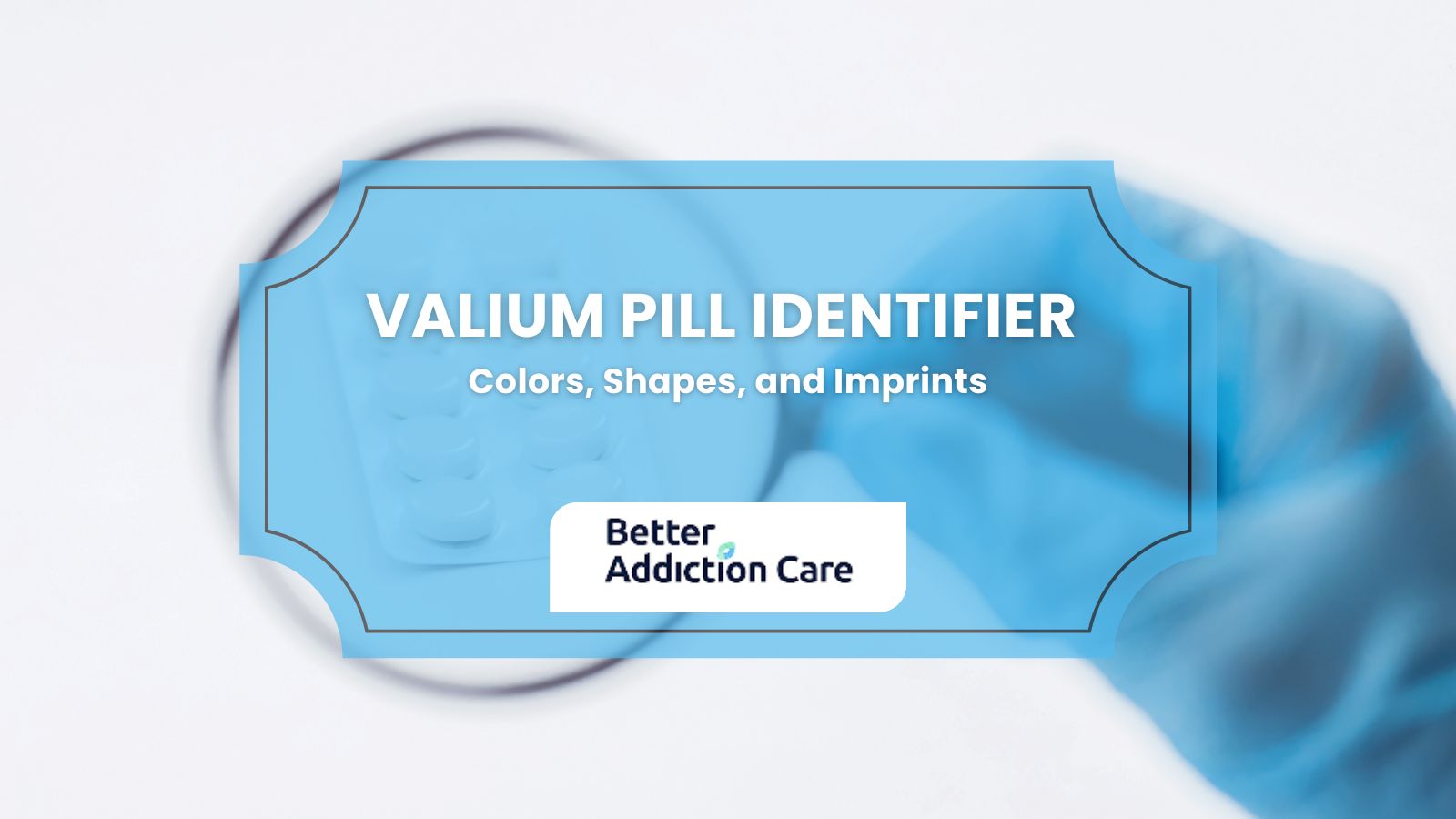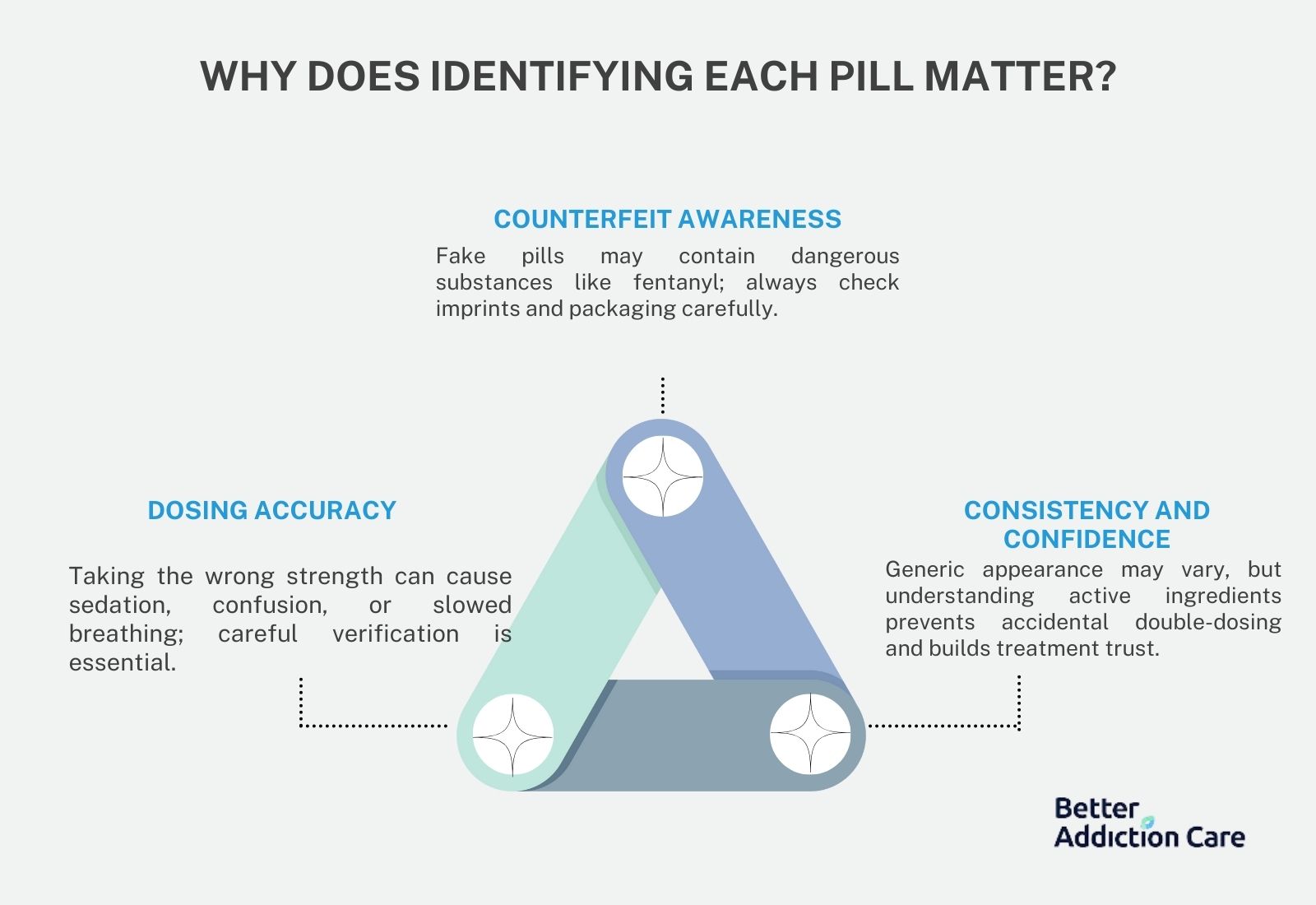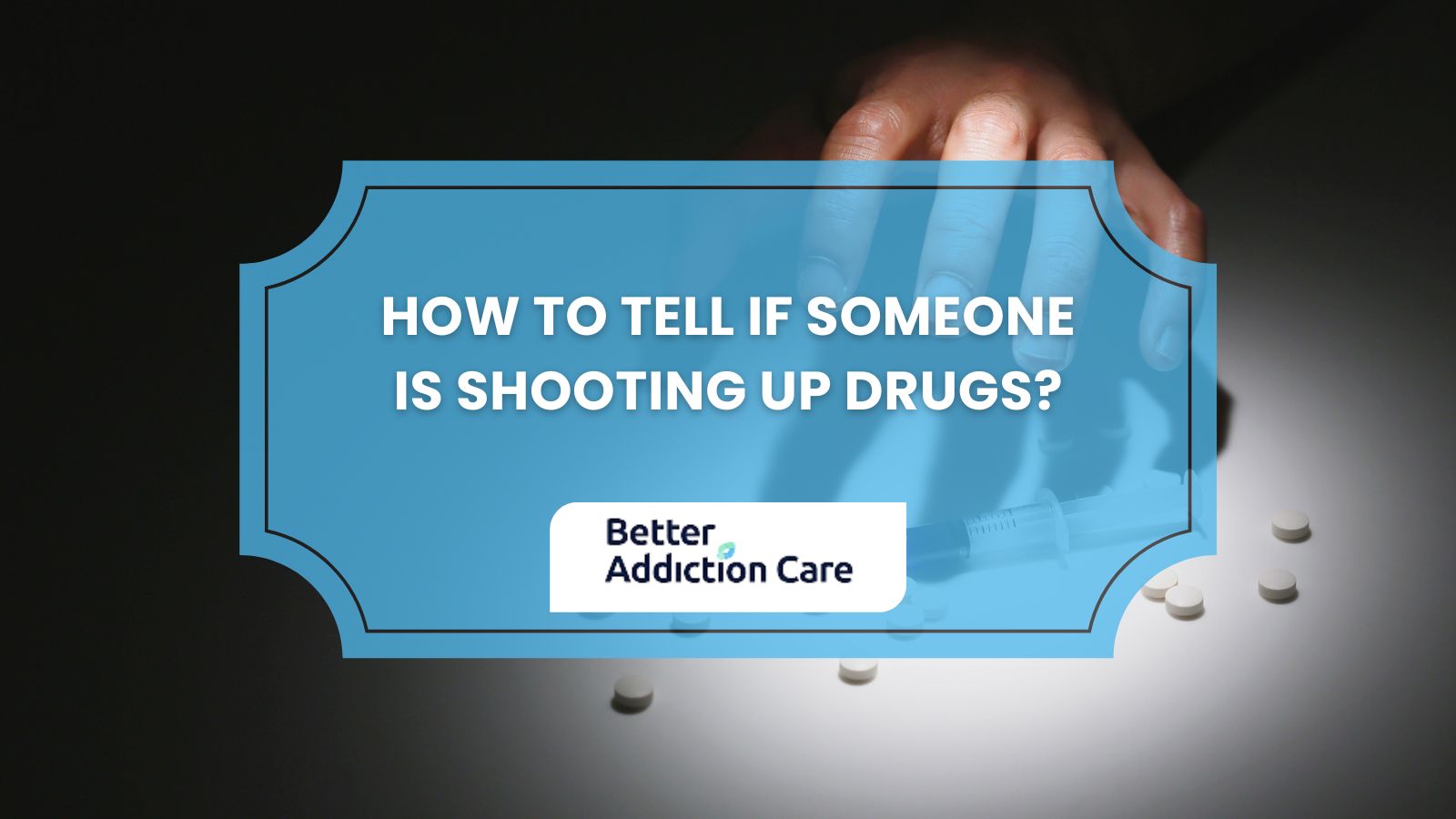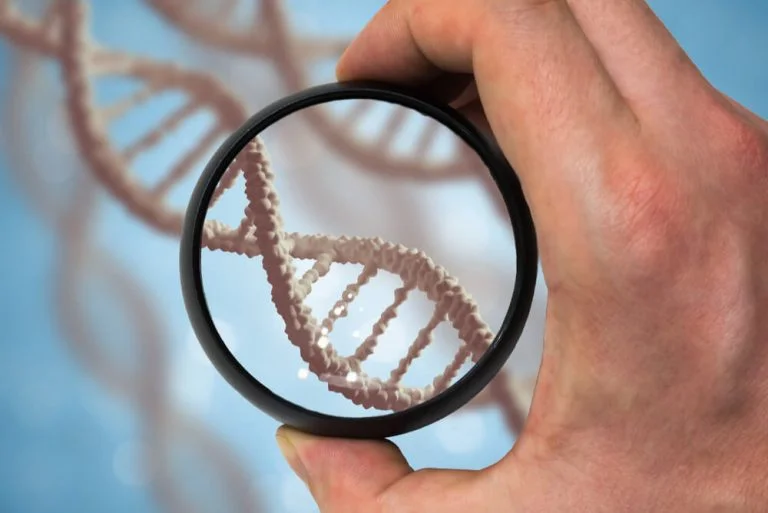Valium Pill Identifier Colors, Shapes, and Imprints
What should I know about Valium?
Valium (generic name: diazepam) is a benzodiazepine medication prescribed to treat conditions such as anxiety disorders, muscle spasms, alcohol withdrawal symptoms, and seizures. It works by calming the brain and nervous system activity.

Doctors often prescribe Valium for:
-
Anxiety disorders
-
Muscle spasms or tension
-
Alcohol withdrawal symptoms
-
Seizures (as part of an anti-seizure plan)
-
Sedation before medical procedures
Valium pills can appear different in color, shape, and imprint depending on the manufacturer and dosage strength.
This helps avoid accidental mix-ups, counterfeit risks, or dosing errors, especially since the FDA warns that fake benzodiazepines sold online have been found laced with fentanyl[1].
Key Takeaways
-
Valium (diazepam) is a prescription benzodiazepine used to treat anxiety, muscle spasms, seizures, and symptoms of alcohol withdrawal.
-
The pill’s color, shape, and imprint vary by dosage strength and manufacturer.
-
Correct pill identification helps prevent accidental misuse, counterfeit exposure, and dosage confusion during refills.
-
Valium pills can range from round blue 10 mg tablets to yellow or white scored tablets in smaller doses.
Counterfeit versions of Valium have been found to contain fentanyl and other dangerous substances, making visual verification essential for safety.
What should I know about Valium?
Valium (generic name: diazepam) is a benzodiazepine medication prescribed to treat conditions such as anxiety disorders, muscle spasms, alcohol withdrawal symptoms, and seizures. It works by calming the brain and nervous system activity.
Doctors often prescribe Valium for:
-
Anxiety disorders
-
Muscle spasms or tension
-
Alcohol withdrawal symptoms
-
Seizures (as part of an anti-seizure plan)
-
Sedation before medical procedures
Valium pills can appear different in color, shape, and imprint depending on the manufacturer and dosage strength.
This helps avoid accidental mix-ups, counterfeit risks, or dosing errors, especially since the FDA warns that fake benzodiazepines sold online have been found laced with fentanyl[1].
Why Does Identifying Each Pill Matter?

Proper identification of Valium protects users from serious dosing mistakes and counterfeit hazards.
Each tablet’s appearance is FDA-verified to communicate dosage and authenticity.
1. Dosing Accuracy
Taking the wrong strength—even one pill off—can lead to excessive sedation, confusion, or slowed breathing.
For example, confusing a 10 mg blue tablet for a 5 mg yellow one doubles the dose.
Patients on multiple medications are especially vulnerable to these mix-ups.
2. Counterfeit Awareness
Counterfeit “Valium” pills are a growing threat.
They may look identical to real diazepam tablets but contain illicit opioids or unsafe fillers. Some fakes tested by U.S. authorities contained fentanyl strong enough to cause an overdose.
Verifying imprint and packaging protects against this danger.
3. Consistency and Confidence
Generic brands differ in color or coating, so a refill may look unfamiliar.
Understanding that appearance changes while the active ingredient remains identical builds trust in your treatment and prevents accidental double-dosing.
How Can I Identify Valium Correctly?

Each Valium or diazepam tablet can be identified by four key features:
-
Color
-
Shape
-
Imprint code
-
Scoring (if present)
You can verify your pill using the Pill Identifier tool on the U.S. National Library of Medicine’s DailyMed site[2] or by comparing it to trusted pharmacy images.
Always check:
-
The imprint code is printed on one or both sides
-
The manufacturer’s name or initials (e.g., TEVA, ROCHE)
-
The color and size of the tablet
-
Whether the tablet is scored (a line indicating it can be safely split)
What do the official colors, shapes, and imprints look like?
Authentic Valium tablets follow precise FDA-approved designs to communicate dose and origin.
Appearance can vary slightly between manufacturers, but every legal tablet will display a clear imprint and consistent shape.
-
The color indicates approximate strength,
-
The shape remains mostly round with smooth edges,
-
The imprint confirms authenticity and dosage,
The following are common forms of Valium and generic diazepam tablets found in the United States.
Actual appearance may vary by manufacturer.
Colors
Keep in mind that color can vary even between legitimate pills.
Factors like lighting, storage, or coating materials can slightly change appearance. Always verify color alongside the imprint and shape for confirmation.
Valium tablets come in distinct colors that help indicate dosage strength:
-
White: Commonly used for 2 mg Valium tablets. These are small, unscored, and typically branded “ROCHE VALIUM 2” or imprinted with a manufacturer code such as “MYLAN 345.”
-
Yellow: Generally represents 5 mg tablets, either branded or generic. The medium-yellow color helps distinguish this mid-range dose. Examples include “ROCHE VALIUM 5,” “TEVA 3926,” or “MYLAN 477.”
-
Blue: Most recognizable as the 10 mg Valium tablet, light blue in color and often scored. Examples include “ROCHE VALIUM 10” or “TEVA 3927.”
-
Green or Light Teal: Some generic diazepam tablets may have pale greenish-blue hues depending on the coating formula or manufacturer’s dye choice.
Shapes
Nearly all Valium and diazepam tablets are round, but subtle differences exist across manufacturers:
-
Round tablets: The standard shape for all primary strengths (2 mg, 5 mg, and 10 mg).
-
Scored tablets: Found on most 5 mg and 10 mg doses, featuring a dividing line that allows accurate splitting when prescribed.
-
Flat-faced or beveled edges: Common among both brand-name and generic Valium. A legitimate pill will have clean edges, uniform texture, and an even finish—details counterfeit pills often miss.
Imprints
The imprint code is the most reliable way to confirm a Valium pill’s authenticity. Every legally distributed prescription tablet in the U.S. must have a unique identifier engraved or printed on its surface.
Below are the most common imprints for both brand-name Valium and its generic versions:
If your Valium or diazepam tablet has no imprint, or the letters and numbers appear blurred, uneven, or misspelled, do not take the pill. These are potential signs of counterfeit production.
You can cross-check any imprint using:
-
FDA’s Pill Identifier Database
-
U.S. National Library of Medicine’s DailyMed listings
-
Or by showing the tablet to a licensed pharmacist for confirmation
Scoring is another official sign
Many Valium tablets are scored, meaning they have a dividing line across the center that allows accurate splitting of the dose if directed by your healthcare provider.
-
Brand-name Valium 5 mg and 10 mg are both scored to permit halving under medical supervision.
-
2 mg tablets are usually unscored due to their small size and lower dosage.
-
Some generic versions may not include a score, even at higher doses — this depends on the manufacturer’s tablet design.
Why Might My Pills Look Different Between Refills?

It’s common for Valium or diazepam pills to look different from one refill to another.
Many patients keep a medication journal or photo log. Note the pill’s appearance and refill date each time—it’s a helpful habit for tracking changes and ensuring consistency.
The main reasons include:
-
Generic substitutions: Pharmacies regularly change suppliers based on inventory, pricing, or insurance contracts. Each manufacturer uses unique coatings, dyes, and tablet molds, which explains slight color or texture changes.
-
Manufacturer updates: Occasionally, companies reformulate coatings or redesign tablets for easier identification, resulting in new shades or size variations.
-
Lighting and storage: Exposure to sunlight, humidity, or temperature fluctuations can cause pills—especially colored ones—to fade or appear discolored.
Appearance changes don’t affect the medication’s performance, but being aware helps avoid anxiety or accidental double-dosing.
If your new refill looks different, check:
-
The pill imprint — it must match the dosage on your prescription label.
-
The manufacturer's name is on the bottle.
-
Ask your pharmacist to confirm the change is legitimate.
What Are the Warning Signs of Counterfeit Pills?
Counterfeit Valium pills often appear authentic but carry dangerous differences. Knowing what to watch for can save your life.
Many counterfeit benzodiazepines are made with illicit fentanyl, an opioid up to 50 times stronger than heroin, which can cause fatal overdoses even in tiny amounts.
Here’s what to watch for:
1. Physical Red Flags
-
No imprint or smudged letters/numbers
-
Uneven coloring or dull finish instead of a smooth coat
-
Crumbly or oily texture when touched
-
Bitter or chemical taste when ingested
-
Packaging inconsistencies, such as missing lot numbers or fake pharmacy labels
2. Source Concerns
-
Pills purchased from social media, unlicensed websites, or acquaintances pose the highest risk.
-
Even online pharmacies that look legitimate can sell fakes. The FDA recommends buying only from NABP-verified pharmacies, which display a “.pharmacy” domain or VIPPS seal[3].
3. Behavioral Red Flags
-
Unexpected reactions like intense drowsiness, confusion, or slowed breathing after taking what you believe is your normal dose.
If that happens, seek immediate emergency help—counterfeit Valium may contain fentanyl or other opioids.
What Should I Do If I Suspect a Counterfeit or Wrong Pill?

Never try to “test” a suspected counterfeit pill yourself using online kits or at-home methods.
These can produce unreliable results and delay proper medical evaluation. Always rely on licensed professionals for verification.
If you believe your Valium tablet looks suspicious or produces unusual effects:
-
Keep the suspect pill and its packaging for examination.
-
Contact your pharmacist right away to verify the imprint and manufacturer.
-
Do not throw the pill away until professionals confirm it’s counterfeit; it may be needed for analysis.
-
Report the incident to the FDA’s MedWatch Safety Information and Adverse Event Reporting Program [4] or your local public health department.
-
Seek emergency care if you experience severe drowsiness, slowed heart rate, or breathing difficulty.
Emergency responders may administer naloxone (Narcan) to reverse opioid effects. Hospitals can perform toxicology tests to identify unknown substances.
Conclusion & Next Steps
Being able to identify your Valium pills correctly is a key step in medication safety. Even minor differences in color or size can raise concern, but understanding why those differences occur helps prevent panic and ensures treatment adherence.
Always:
-
Verify the imprint, shape, and color before taking a dose.
-
Refill prescriptions only from licensed, NABP-approved pharmacies.
-
Ask your pharmacist to confirm any appearance change before use.
-
Report suspicious pills to the FDA MedWatch if you believe they’re counterfeit.
Today’s digital resources make identification easier than ever. Tools like the DailyMed Pill Finder allow quick verification, while pharmacists can explain manufacturer variations.
Staying informed, observant, and proactive helps you use Valium safely and confidently—protecting yourself and your loved ones from the real dangers of counterfeit medications.
FAQs
Real Valium tablets are round with clear imprints. The 10 mg pill is light blue and marked “ROCHE VALIUM 10.” The 5 mg version is yellow with “ROCHE VALIUM 5,” and the 2 mg version is white with “ROCHE VALIUM 2.” Generic versions may look slightly different but will always include a manufacturer imprint like “TEVA” or “MYLAN.”
Fake Valium pills may have blurry or missing imprints, inconsistent coloring, or unusual texture. Some counterfeit pills contain fentanyl, which can cause severe overdose symptoms. Always verify imprints using FDA or DailyMed tools and only use medication dispensed by a licensed pharmacy.
Yes, generic diazepam contains the same active ingredient and therapeutic effect as brand-name Valium. Differences may include inactive ingredients, color, or shape, depending on the manufacturer. Always confirm dosage consistency with your pharmacist when refilling.
Pharmacies sometimes switch generic manufacturers, leading to small visual differences in shape or color. As long as the imprint code and dosage match, the medication works the same way.
Yes. Valium tablets typically expire 2–3 years after manufacture. Expired pills may lose strength or change color slightly. To dispose safely, use a DEA-authorized take-back site or follow pharmacy disposal instructions—never flush medication down the drain unless explicitly directed.
If you find an unmarked or suspicious pill, don’t take it. Use an online pill identifier from the FDA or Drugs.com, or bring it to a pharmacy for professional verification. Taking unknown pills can be extremely dangerous.
Both Valium and Xanax are benzodiazepines, and some of their tablets may appear similar in size or color. However, Xanax tablets are often rectangular (“bars”) while Valium is usually round. Always verify the imprint—Xanax typically reads “XANAX” or “GG” followed by numbers, while Valium carries “ROCHE VALIUM” or a manufacturer imprint like “TEVA.”
Resources
Related Articles
Treatment Centers in Arizona










